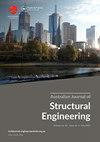Evaluation of self-healing performance of concrete containing fly ash and fibres
IF 1.3
Q4 ENGINEERING, CIVIL
Australian Journal of Structural Engineering
Pub Date : 2021-06-09
DOI:10.1080/13287982.2021.1935426
引用次数: 1
Abstract
ABSTRACT Since the existence of cracks reduces the concrete service life, the self-healing ability of concrete has attracted the attention of researchers. In this article, effects of fly ash and steel/polypropylene fibres on the self-healing ability of concrete were investigated separately and together. The cylindrical specimens were pre-cracked by means of a tensile strength test at 28 days. Secondary tensile test was performed immediately after pre-cracking and 28 and 56 days after re-curing in water. Also, to monitor microcracks in concrete after pre-cracking and during the self-healing period, the ultrasonic pulse velocity and permeability tests were conducted. The results showed that 15% fly ash replacement led to 94% reduction in permeability and almost complete recovery in secondary tensile strength after 8 weeks of re-curing. Although the specimen with polypropylene lost lower tensile strength among specimens with fibre immediately after pre-loading (22%), the improvement rate of those during the self-healing period was only 27%.掺粉煤灰和纤维混凝土自愈性能评价
由于裂缝的存在降低了混凝土的使用寿命,混凝土的自愈能力引起了研究者的关注。本文分别和共同研究了粉煤灰和钢/聚丙烯纤维对混凝土自愈能力的影响。通过28天的拉伸强度试验对圆柱形试样进行预裂。预裂后立即进行二次拉伸试验,水中再固化后28和56 d进行二次拉伸试验。为了监测混凝土预裂后和自愈期的微裂缝,进行了超声脉冲速度和渗透性试验。结果表明,掺加15%粉煤灰后,再养护8周后,渗透率降低94%,二次抗拉强度几乎完全恢复。预加载后聚丙烯试样的抗拉强度损失较纤维试样低(22%),但自愈期的改善率仅为27%。
本文章由计算机程序翻译,如有差异,请以英文原文为准。
求助全文
约1分钟内获得全文
求助全文
来源期刊

Australian Journal of Structural Engineering
ENGINEERING, CIVIL-
CiteScore
2.50
自引率
0.00%
发文量
31
期刊介绍:
The Australian Journal of Structural Engineering (AJSE) is published under the auspices of the Structural College Board of Engineers Australia. It fulfils part of the Board''s mission for Continuing Professional Development. The journal also offers a means for exchange and interaction of scientific and professional issues and technical developments. The journal is open to members and non-members of Engineers Australia. Original papers on research and development (Technical Papers) and professional matters and achievements (Professional Papers) in all areas relevant to the science, art and practice of structural engineering are considered for possible publication. All papers and technical notes are peer-reviewed. The fundamental criterion for acceptance for publication is the intellectual and professional value of the contribution. Occasionally, papers previously published in essentially the same form elsewhere may be considered for publication. In this case acknowledgement to prior publication must be included in a footnote on page one of the manuscript. These papers are peer-reviewed as new submissions. The length of acceptable contributions typically should not exceed 4,000 to 5,000 word equivalents. Longer manuscripts may be considered at the discretion of the Editor. Technical Notes typically should not exceed about 1,000 word equivalents. Discussions on a Paper or Note published in the AJSE are welcomed. Discussions must address significant matters related to the content of a Paper or Technical Note and may include supplementary and critical comments and questions regarding content.
 求助内容:
求助内容: 应助结果提醒方式:
应助结果提醒方式:


